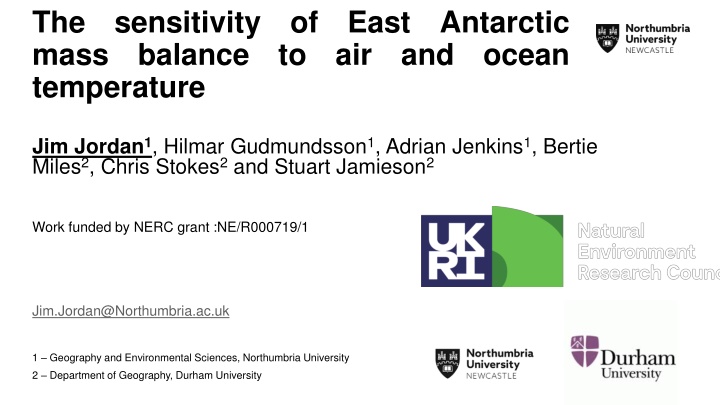
Antarctic East Air-Ocean Mass Balance Study
"Explore the impacts of climate scenarios on East Antarctic ice mass balance over the next century, including the potential effects of precipitation and oceanic melting. Results suggest precipitation may counterbalance ice discharge from warming oceans. Stay informed on the latest research in Antarctic climate dynamics."
Download Presentation

Please find below an Image/Link to download the presentation.
The content on the website is provided AS IS for your information and personal use only. It may not be sold, licensed, or shared on other websites without obtaining consent from the author. If you encounter any issues during the download, it is possible that the publisher has removed the file from their server.
You are allowed to download the files provided on this website for personal or commercial use, subject to the condition that they are used lawfully. All files are the property of their respective owners.
The content on the website is provided AS IS for your information and personal use only. It may not be sold, licensed, or shared on other websites without obtaining consent from the author.
E N D
Presentation Transcript
The mass temperature sensitivity balance of to East air Antarctic and ocean Jim Jordan1, Hilmar Gudmundsson1, Adrian Jenkins1, Bertie Miles2, Chris Stokes2and Stuart Jamieson2 Work funded by NERC grant :NE/R000719/1 Jim.Jordan@Northumbria.ac.uk 1 Geography and Environmental Sciences, Northumbria University 2 Department of Geography, Durham University
Aims Determine how the EAIS mass balance is likely to change over the next 100 years. Assess the impact of different climate scenarios upon the EAIS mass balance. Assess the potential change in EAIS mass balance arising from a regime shift from predominantly ABW driven melting to CDW driven melting. Determine to what extent increased precipitation could counterbalance increased oceanic melting.
Methodology - Schematic RACMO precipitation model Air temperature change Precipitation a Ice model Change in EAIS mass PICO box ocean model Melting Ocean properties change
Results - Disclaimer Please bear in mind that results are very much work in progress, and should be considered as such. Initial simulations have been performed, but investigations into model sensitivity to various parameters are still ongoing. All results are shown in reference to a base simulation with present day forcing, therefore plots show this relative change in ice volume above flotation, ice volume or grounded ice area rather than absolute values.
Conclusion Increased precipitation from a warming atmosphere has the potential to offset increased ice discharge from a warming ocean in regards to the mass balance of the EAIS over the next 100 years. A reduction in grounded ice sheet area (and hence a reduction in volume above floatation) is more than compensated by inland precipitation. Simulations show that if East Antarctic ice-shelf melt continues to be driven by Antarctic Bottom Water, then total ice volume is likely to be kept approximately constant, or actually slightly increase under the warmest air temperatures. However, if ocean melting becomes predominantly driven by Circumpolar Deep Water then ice volume will decrease due to floating ice shelves melting, even if the volume of grounded ice above flotation increases. In the case of the EAIS, the relative increase in VAF from precipitation and decrease in VAF from increased ice discharge are of roughly similar magnitudes. Small changes in the assumptions used here are likely to affect not just the magnitude of future mass balance change, but potentially also the sign.






















